reset BUICK RANDEZVOUS 2007 Owner's Guide
[x] Cancel search | Manufacturer: BUICK, Model Year: 2007, Model line: RANDEZVOUS, Model: BUICK RANDEZVOUS 2007Pages: 528, PDF Size: 2.99 MB
Page 414 of 528
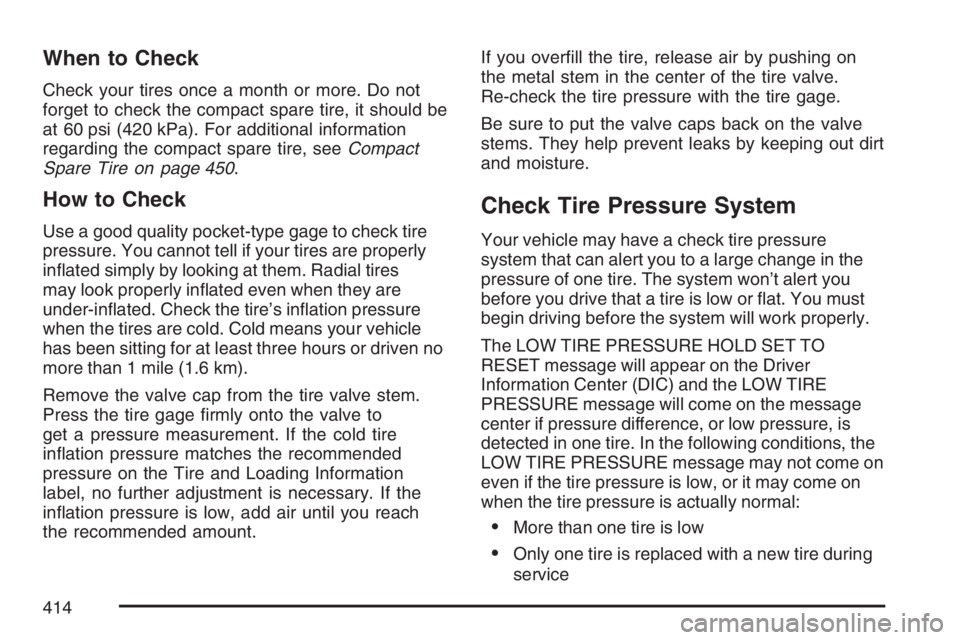
When to Check
Check your tires once a month or more. Do not
forget to check the compact spare tire, it should be
at 60 psi (420 kPa). For additional information
regarding the compact spare tire, seeCompact
Spare Tire on page 450.
How to Check
Use a good quality pocket-type gage to check tire
pressure. You cannot tell if your tires are properly
in�ated simply by looking at them. Radial tires
may look properly in�ated even when they are
under-in�ated. Check the tire’s in�ation pressure
when the tires are cold. Cold means your vehicle
has been sitting for at least three hours or driven no
more than 1 mile (1.6 km).
Remove the valve cap from the tire valve stem.
Press the tire gage �rmly onto the valve to
get a pressure measurement. If the cold tire
in�ation pressure matches the recommended
pressure on the Tire and Loading Information
label, no further adjustment is necessary. If the
in�ation pressure is low, add air until you reach
the recommended amount.If you over�ll the tire, release air by pushing on
the metal stem in the center of the tire valve.
Re-check the tire pressure with the tire gage.
Be sure to put the valve caps back on the valve
stems. They help prevent leaks by keeping out dirt
and moisture.
Check Tire Pressure System
Your vehicle may have a check tire pressure
system that can alert you to a large change in the
pressure of one tire. The system won’t alert you
before you drive that a tire is low or �at. You must
begin driving before the system will work properly.
The LOW TIRE PRESSURE HOLD SET TO
RESET message will appear on the Driver
Information Center (DIC) and the LOW TIRE
PRESSURE message will come on the message
center if pressure difference, or low pressure, is
detected in one tire. In the following conditions, the
LOW TIRE PRESSURE message may not come on
even if the tire pressure is low, or it may come on
when the tire pressure is actually normal:
More than one tire is low
Only one tire is replaced with a new tire during
service
414
Page 415 of 528
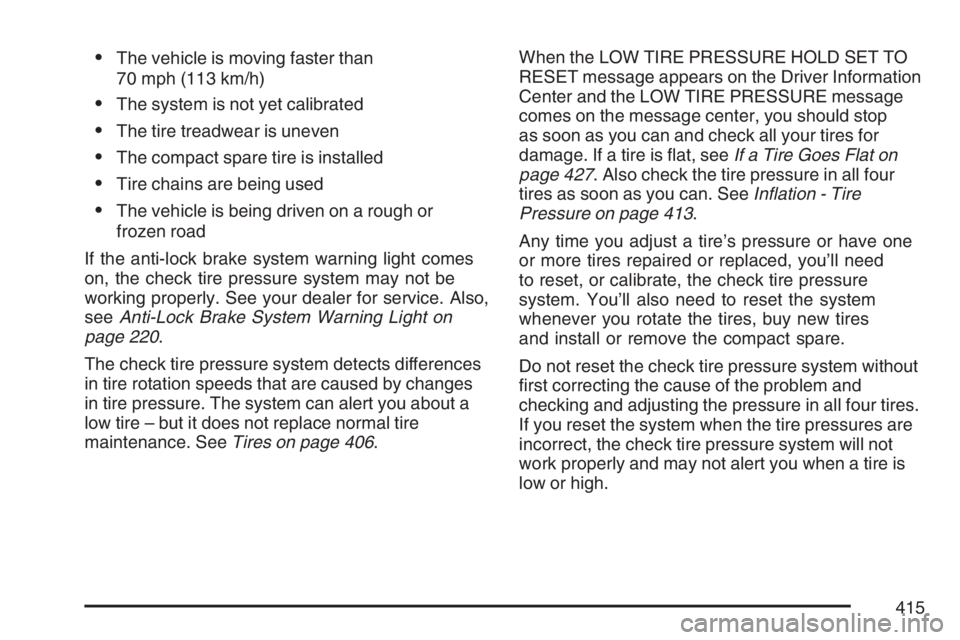
The vehicle is moving faster than
70 mph (113 km/h)
The system is not yet calibrated
The tire treadwear is uneven
The compact spare tire is installed
Tire chains are being used
The vehicle is being driven on a rough or
frozen road
If the anti-lock brake system warning light comes
on, the check tire pressure system may not be
working properly. See your dealer for service. Also,
seeAnti-Lock Brake System Warning Light on
page 220.
The check tire pressure system detects differences
in tire rotation speeds that are caused by changes
in tire pressure. The system can alert you about a
low tire – but it does not replace normal tire
maintenance. SeeTires on page 406.When the LOW TIRE PRESSURE HOLD SET TO
RESET message appears on the Driver Information
Center and the LOW TIRE PRESSURE message
comes on the message center, you should stop
as soon as you can and check all your tires for
damage. If a tire is �at, seeIf a Tire Goes Flat on
page 427. Also check the tire pressure in all four
tires as soon as you can. SeeIn�ation - Tire
Pressure on page 413.
Any time you adjust a tire’s pressure or have one
or more tires repaired or replaced, you’ll need
to reset, or calibrate, the check tire pressure
system. You’ll also need to reset the system
whenever you rotate the tires, buy new tires
and install or remove the compact spare.
Do not reset the check tire pressure system without
�rst correcting the cause of the problem and
checking and adjusting the pressure in all four tires.
If you reset the system when the tire pressures are
incorrect, the check tire pressure system will not
work properly and may not alert you when a tire is
low or high.
415
Page 416 of 528
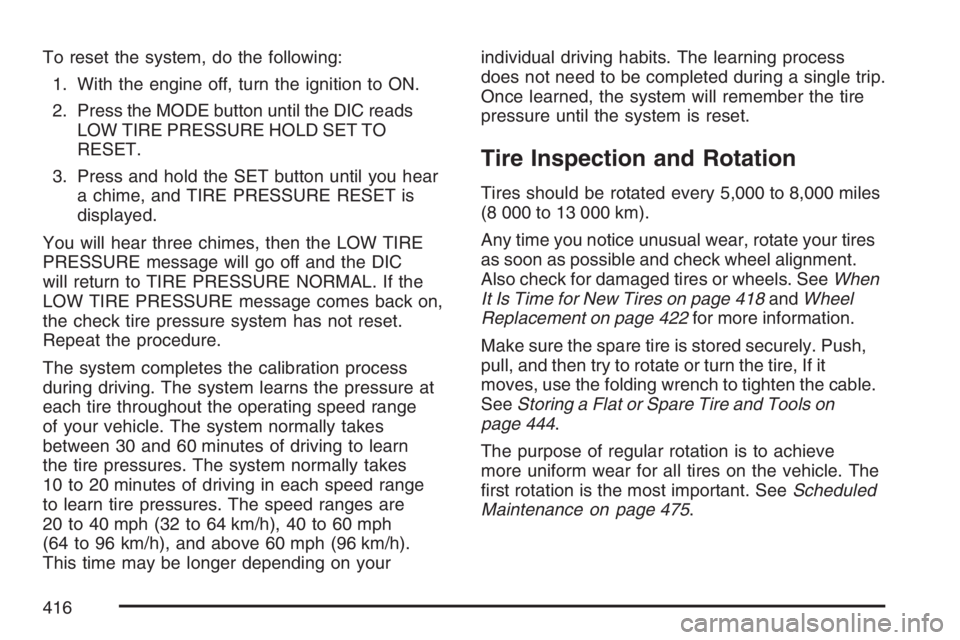
To reset the system, do the following:
1. With the engine off, turn the ignition to ON.
2. Press the MODE button until the DIC reads
LOW TIRE PRESSURE HOLD SET TO
RESET.
3. Press and hold the SET button until you hear
a chime, and TIRE PRESSURE RESET is
displayed.
You will hear three chimes, then the LOW TIRE
PRESSURE message will go off and the DIC
will return to TIRE PRESSURE NORMAL. If the
LOW TIRE PRESSURE message comes back on,
the check tire pressure system has not reset.
Repeat the procedure.
The system completes the calibration process
during driving. The system learns the pressure at
each tire throughout the operating speed range
of your vehicle. The system normally takes
between 30 and 60 minutes of driving to learn
the tire pressures. The system normally takes
10 to 20 minutes of driving in each speed range
to learn tire pressures. The speed ranges are
20 to 40 mph (32 to 64 km/h), 40 to 60 mph
(64 to 96 km/h), and above 60 mph (96 km/h).
This time may be longer depending on yourindividual driving habits. The learning process
does not need to be completed during a single trip.
Once learned, the system will remember the tire
pressure until the system is reset.
Tire Inspection and Rotation
Tires should be rotated every 5,000 to 8,000 miles
(8 000 to 13 000 km).
Any time you notice unusual wear, rotate your tires
as soon as possible and check wheel alignment.
Also check for damaged tires or wheels. SeeWhen
It Is Time for New Tires on page 418andWheel
Replacement on page 422for more information.
Make sure the spare tire is stored securely. Push,
pull, and then try to rotate or turn the tire, If it
moves, use the folding wrench to tighten the cable.
SeeStoring a Flat or Spare Tire and Tools on
page 444.
The purpose of regular rotation is to achieve
more uniform wear for all tires on the vehicle. The
�rst rotation is the most important. SeeScheduled
Maintenance on page 475.
416
Page 417 of 528

When rotating your tires, always use the correct
rotation pattern shown here.
Do not include the compact spare tire in your tire
rotation.
After the tires have been rotated, adjust the front
and rear in�ation pressures as shown on the
Tire and Loading Information label.
Reset the check tire pressure system, if equipped.
SeeCheck Tire Pressure System on page 414.Make certain that all wheel nuts are properly
tightened. See “Wheel Nut Torque” under
Capacities and Speci�cations on page 469.
{CAUTION:
Rust or dirt on a wheel, or on the parts to
which it is fastened, can make wheel nuts
become loose after time. The wheel could
come off and cause an accident. When
you change a wheel, remove any rust or
dirt from places where the wheel attaches
to the vehicle. In an emergency, you can
use a cloth or a paper towel to do this;
but be sure to use a scraper or wire brush
later, if needed, to get all the rust or dirt
off. SeeChanging a Flat Tire on page 428.
417
Page 475 of 528
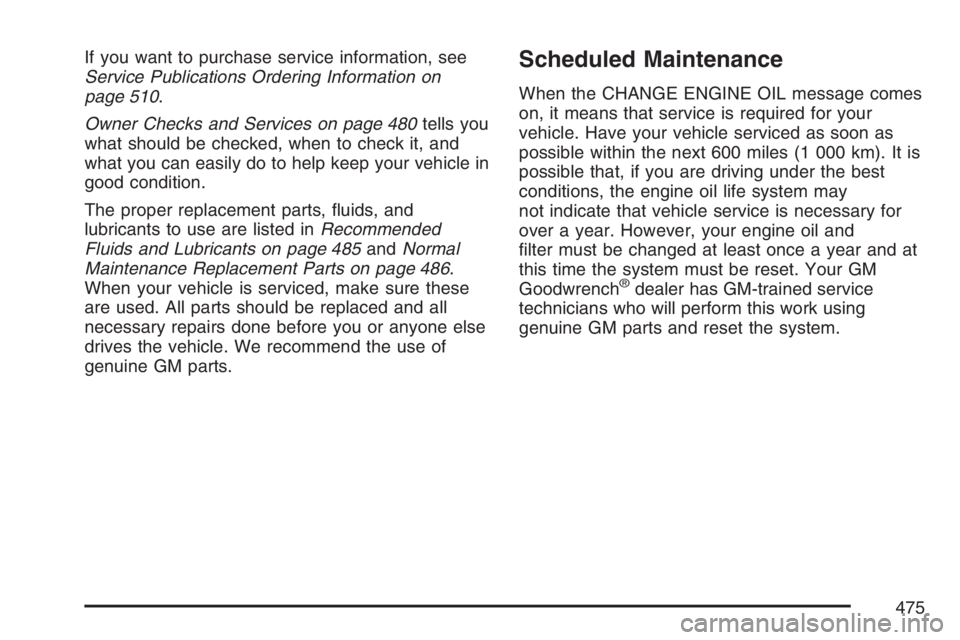
If you want to purchase service information, see
Service Publications Ordering Information on
page 510.
Owner Checks and Services on page 480tells you
what should be checked, when to check it, and
what you can easily do to help keep your vehicle in
good condition.
The proper replacement parts, �uids, and
lubricants to use are listed inRecommended
Fluids and Lubricants on page 485andNormal
Maintenance Replacement Parts on page 486.
When your vehicle is serviced, make sure these
are used. All parts should be replaced and all
necessary repairs done before you or anyone else
drives the vehicle. We recommend the use of
genuine GM parts.Scheduled Maintenance
When the CHANGE ENGINE OIL message comes
on, it means that service is required for your
vehicle. Have your vehicle serviced as soon as
possible within the next 600 miles (1 000 km). It is
possible that, if you are driving under the best
conditions, the engine oil life system may
not indicate that vehicle service is necessary for
over a year. However, your engine oil and
�lter must be changed at least once a year and at
this time the system must be reset. Your GM
Goodwrench
®dealer has GM-trained service
technicians who will perform this work using
genuine GM parts and reset the system.
475
Page 476 of 528
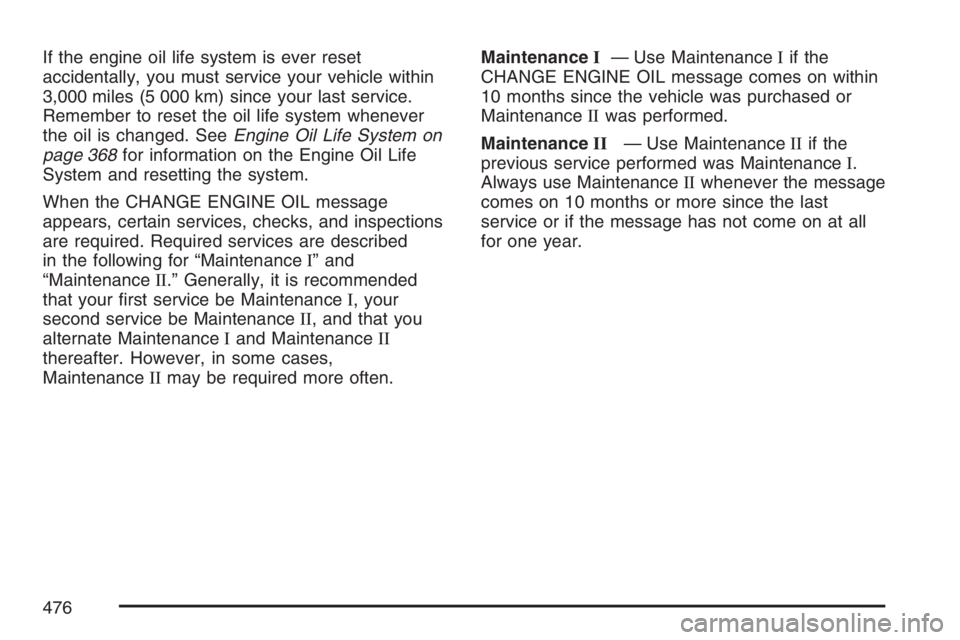
If the engine oil life system is ever reset
accidentally, you must service your vehicle within
3,000 miles (5 000 km) since your last service.
Remember to reset the oil life system whenever
the oil is changed. SeeEngine Oil Life System on
page 368for information on the Engine Oil Life
System and resetting the system.
When the CHANGE ENGINE OIL message
appears, certain services, checks, and inspections
are required. Required services are described
in the following for “MaintenanceI” and
“MaintenanceII.” Generally, it is recommended
that your �rst service be MaintenanceI, your
second service be MaintenanceII, and that you
alternate MaintenanceIand MaintenanceII
thereafter. However, in some cases,
MaintenanceIImay be required more often.MaintenanceI— Use MaintenanceIif the
CHANGE ENGINE OIL message comes on within
10 months since the vehicle was purchased or
MaintenanceIIwas performed.
MaintenanceII— Use MaintenanceIIif the
previous service performed was MaintenanceI.
Always use MaintenanceIIwhenever the message
comes on 10 months or more since the last
service or if the message has not come on at all
for one year.
476
Page 477 of 528

Scheduled Maintenance
Service MaintenanceIMaintenanceII
Change engine oil and �lter. SeeEngine Oil on page 365. Reset oil life system.
SeeEngine Oil Life System on page 368.An Emission Control Service.••
Visually check for any leaks or damage.See footnote (j).••
Inspect engine air cleaner �lter. If necessary, replace �lter. SeeEngine Air
Cleaner/Filter on page 370.See footnote (l).•
Rotate tires and check in�ation pressures and wear. SeeTire Inspection and
Rotation on page 416and “Tire Wear Inspection” inAt Least Once a Month on
page 481.••
Inspect brake system.See footnote (a).••
Check engine coolant and windshield washer �uid levels and add �uid as
needed.••
Perform any needed additional services. See “Additional Required Services” in
this section.••
Inspect suspension and steering components.See footnote (b).•
Inspect engine cooling system.See footnote (c).•
Inspect wiper blades.See footnote (d).•
Inspect restraint system components.See footnote (e).•
Lubricate body components.See footnote (f).•
Check transaxle �uid level and add �uid as needed.•
Inspect throttle system.See footnote (j).•
Replace passenger compartment air �lter.See footnote (k).•
477